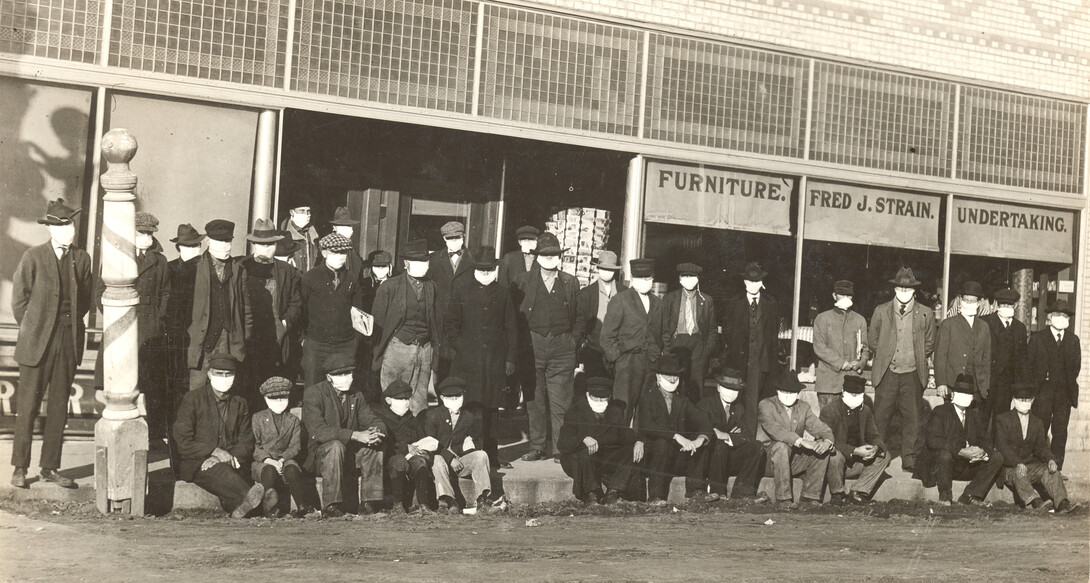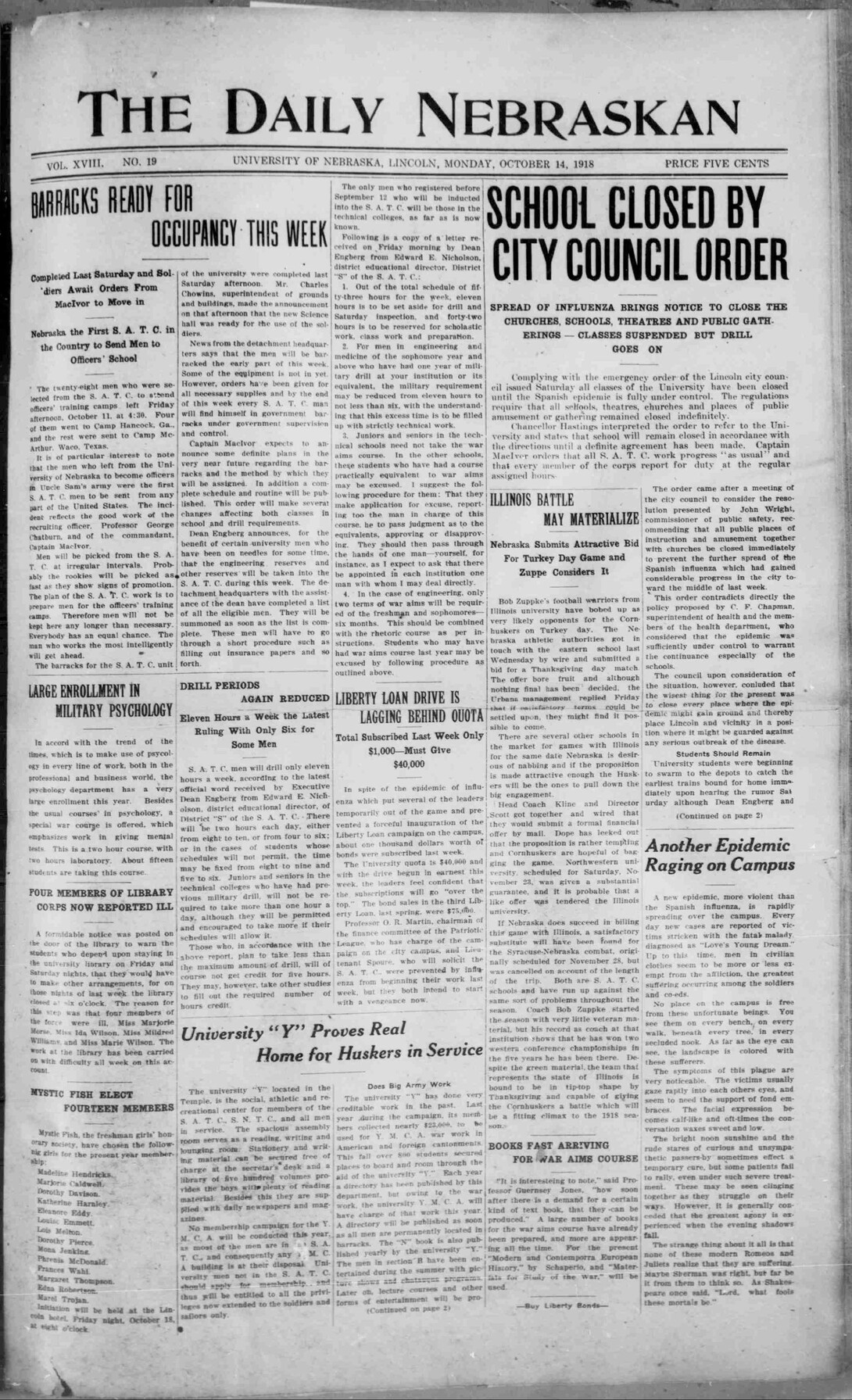
Editor’s Note — This is an excerpt from the cover story of the Summer 2020 edition of Nebraska Quarterly. The full article is available on the Nebraska Alumni Association’s website.
The illness announced itself to campus on a Tuesday.
To that point, the virus had existed as a distant threat; one would hear rumors of infections spreading across other countries and cities, of hospitals overflowing with the sick, morgues overflowing with the dead.
Then, all at once, eleven students were sick. One in the hospital, the others confined to their homes.
That day’s edition of The Daily Nebraskan proclaimed on its front page: “Spanish Influenza Makes Appearance at University, Authorities May Have to Adopt Severe Preventive Methods.”

The virus would go on to take some 50-100 million lives worldwide, and kill an estimated 2,800-7,500 Nebraskans, according to the State Historical Society. It would also dramatically change the way the world looked at contagions and create preparation measures — at the university and beyond — for the next time an illness spread like wildfire around the globe.
Now, just more than a century later, a new pandemic — COVID-19 — rages, shuttering the university, and sickening and killing scores of people. The lessons learned from the past are visible, even as this new virus attacks in its own way, impacting not just the university, but the lives of alumni worldwide.
COVID-19 was first identified as a new infection in Wuhan, China, in December 2019. In January, it arrived in the United States, where it gained a foothold in Seattle. Sean Fisher (’13), saw the spread firsthand at the University of Washington Medical Center, where he’s in the third year of residency in plastic and reconstructive surgery. Even as the hospital was inundated — and knowing staff were at high risk — Fisher said every doctor was focused only on treating the ill.
“You have a job to do,” Fisher told KLKN-TV.
Closing down
With the threat of COVID growing nationally, in March, schools began to shutter, and state and local governments restricted businesses and movement of people. On March 12, Chancellor Ronnie Green announced that classes would be canceled March 16-20, and that after spring break, all classes would be taught remotely. On April 7, the University of Nebraska system closed its campuses entirely.
In 1918, the Board of Regents had resisted shuttering the university even as the Spanish flu infected more and more students. It took two weeks — and numerous student deaths — before the State Health Board forced UNL to close. Amid the COVID crisis, the university’s current leadership was proactive in ensuring the virus wouldn’t devastate students.
As faculty members rushed to familiarize themselves with new technologies to move their coursework and grading to a remote system, students rushed to find ways to get back home.
Jason Dunn (’12), had moved to New York City to experience its famed hustle and bustle. At first, as COVID cases began to appear, the city’s mayor told residents to continue as normal. Dunn kept commuting from his home in Harlem to his office at TLC Marketing in Manhattan.
“Then it felt like it hit all at once,” Dunn said. “The city was shut down, and we had to adjust to this new New York.”
Outside, it felt like the set of a post-apocalyptic movie, he said. No one walking. No cars or taxis. “It’s nothing but sirens here anymore,” he said, describing the nonstop sound of ambulances rushing COVID patients to overwhelmed hospitals.
Battling misinformation
Looking through The Daily Nebraskan archives from 1918, there would be one story per day about the pandemic, and often it would lament forced closures or the cancellation of football games.
Students falling ill and dying were often footnotes, constrained to inside pages. It’s impossible to gain any real idea of how many fell victim to the virus, though at least hundreds of students were said to be sickened.
Some of this could owe to the fact that the world remained locked in World War I. And on Oct. 18, as campus remained closed, The Daily Nebraskan was taken over by the government, to serve as the official publication of the Student Army Training Corps — the equivalent of the ROTC.
Censorship was common during the war, but in this case it meant that even as the DN was the most prominent newspaper in Lincoln, its coverage focused on painting the SATC in the best light. Even though SATC members were struck hard by influenza, more coverage was given to one unit’s mascot — a pet dog.
The importance of information and communication in combating a crisis is something Lee Rood (’90), knows all about. Rood, an investigative reporter for the Des Moines Register in Iowa, covered the Sept. 11 terrorist attacks from Ground Zero in New York.
She said in many ways, COVID is a bigger story, causing far more deaths and a far greater impact on people’s lives. Covering it, meanwhile, is one of the greatest struggles of her career.
“So many people rely on news sources that aren’t credible,” she said. “Information spreads through social media with no regard for where it comes from. Professional journalists are just trying to get good, unbiased information out there for people to process.”
Looking back, and forward
In looking back at 1918, maybe the ultimate lesson about pandemics is that, for as much damage as they do and as much tumult as they cause, eventually, mercifully, they do end.
A century ago the university closed on Oct. 14, and the entire state went under a quarantine on Oct. 22. But by early November, the university reopened to students. The “enforced vacation has been a dull one for both soldiers and girls,” an article notes.
Soon, focus would be back to social gatherings and the big Husker matchup against Notre Dame.
The impact, however, lingered. There were those who had died, and all those who grieved the dead.
For famed Nebraska author Willa Cather (1895, 1917), the Spanish flu pandemic stayed in her thoughts for years as she worked on what would become her Pulitzer Prize-winning novel, One of Ours. It tells the story of a Nebraskan gone off to fight in World War I, who sees the horrors of illness and war. A novel that ends with a searing portrait of a mother gripped by relief and sorrow:
“She feels as if God had saved him from some horrible suffering, some horrible end. For as she reads, she thinks those slayers of themselves were all so like him; they were the ones who had hoped extravagantly — who in order to do what they did had to hope extravagantly, and to believe passionately. And they found they had hoped and believed too much. But one she knew, who could ill bear disillusion … safe, safe.”







